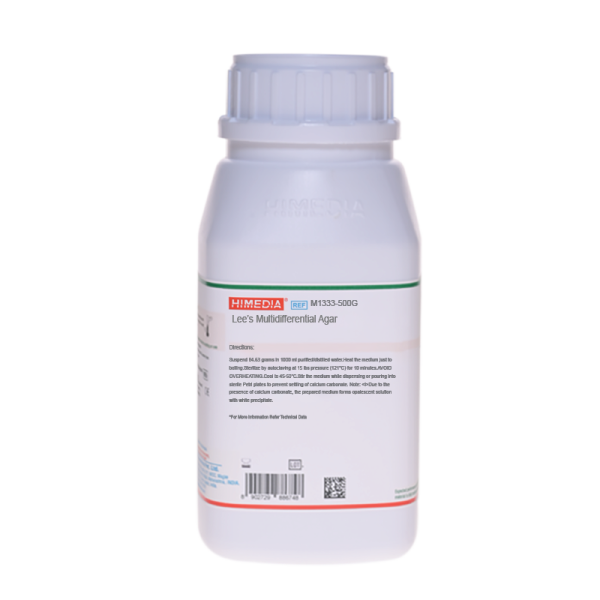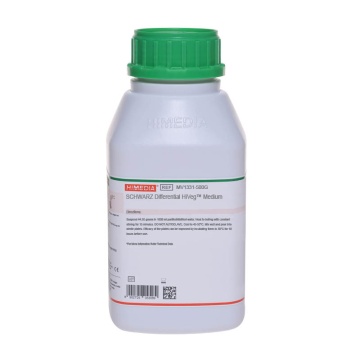 Your enquiry has been submitted
Your enquiry has been submitted
Lee’s Multidifferential Agar
Intended Use
Recommended for the cultivation and identification of brewing bacteria including fastidious type.
Composition**
| Ingredients | Gms/Litre |
|---|---|
| Tomato Juice broth | 41.000 |
| Peptonized SM powder $ | 20.000 |
| Calcium pantothenate | 2.000 |
| Citric acid | 1.100 |
| Calcium carbonate | 5.000 |
| Polysorbate 80 (Tween 80) | 0.500 |
| Bromo cresol green | 0.022 |
| Cycloheximide | 0.007 |
| Agar | 15.000 |
Final pH (at 25°C): 5.5±0.2
**Formula adjusted, standardized to suit performance parameters
$ Equivalent to Peptonized milk
Directions
Suspend 84.63 grams in 1000 ml purified/distilled water. Heat the medium just to boiling. Sterilize by autoclaving at 15 lbs pressure (121°C) for 10 minutes. AVOID OVERHEATING. Stir the medium while dispensing to prevent settling of calcium carbonate.
Note: Due to the presence of calcium carbonate, the prepared medium forms opalescent solution with white precipitate.
Principle And Interpretation
Lee's Multidifferential Agar is a nutrient medium that detects most organisms commonly found in the brewery. Beer is not a very appropriate medium for the development of bacteria due to its characteristics, such as the low quantity of available nutrients, the presence of alcohol, carbon dioxide and sulphur dioxide, as well as low conservation temperatures. Beer filtration and pasteurization phases also contribute to the stabilization of the product against microorganisms (3).
Lee's Multidifferential Agar contains Tomato juice broth which provides nutrients and acid environment for the growth of acidophilic bacteria. Peptonized milk provides lactose as an energy source. The low pH of the medium inhibits bacteria other than acidophilic bacteria. Polysorbate 80 serves as a source of fatty acids. Bromo cresol green acts as a pH indicator. Acid producing bacteria produce a clear yellow halo around the colonies. Other bacteria produce colonies in colours ranging from colourless to yellow green and blue depending on species and strain. Further tests should be carried out for their identification.
Lactic and acetic acid bacteria are differentiated from non-acid producers by giving a yellow colour to the medium and producing a clear halo zone; Lactobacilli appear translucent to greenish white with dark green center. All lactobacilli have a well-developed halo zone; Pediococcus generally produces tiny greenish colonies surrounded by a narrow halo zone; Acetobacter produces a weak halo zone, Acetomonas produces a substantial halo zone; non-acid producers such as Flavobacterium, Zymomonas and Enterobacter) do not produce halo zone or yellow colour in the medium around colonies (4).
Type of specimen
Brewery samples
Specimen Collection and Handling
For brewery samples, follow appropriate techniques for sample collection and processing as per guidelines (1,2). After use, contaminated materials must be sterilized by autoclaving before discarding.
Warning and Precautions
Read the label before opening the container. Wear protective gloves/protective clothing/eye protection/face protection. Follow good microbiological lab practices while handling specimens and culture. Standard precautions as per established guidelines should be followed while handling clinical specimens. Safety guidelines may be referred in individual safety data sheets.
Limitations :
- Further biochemical and serological tests must be carried out for complete identification.
Performance and Evaluation
Performance of the medium is expected when used as per the direction on the label within the expiry period when stored at recommended temperature.
Quality Control
Appearance Ligth yellow to light green homogeneous free flowing powder
Gelling Firm, comparable with 1.5% Agar gel
Colour and Clarity of prepared medium Green to light blue coloured opaque gel forms in Petri plates.
Reaction Reaction of 8.5% w/v aqueous solution at 25°C. pH: 5.5±0.2
pH 5.30-5.70
Cultural Response Cultural characteristics observed after an incubation at 25-30°C for 48-72 hours.
| Organism | Growth |
|---|---|
| Acinetobacter calcoaceticus ATCC 23055 | none-poor |
| Lactobacillus acidophilus ATCC 4356 | luxuriant with clear yellow halo |
| Lactobacillus fermentum ATCC 9338 | luxuriant with clear yellow halo |
| Lactobacillus leichmannii ATCC 4797 | luxuriant with clear yellow halo |
| Lactobacillus plantarum ATCC 8014 | luxuriant with clear yellow halo |
| Proteus vulgaris ATCC 13315 | inhibited |
Storage and Shelf Life
Store dehydrated and the prepared medium at 2-8°C. Use before expiry date on the label. On opening, product should be properly stored dry, after tightly capping the bottle in order to prevent lump formation due to the hygroscopic nature of the product. Improper storage of the product may lead to lump formation. Store in dry ventilated area protected from extremes of temperature and sources of ignition. Seal the container tightly after use. Product performance is best if used within stated expiry period.
Disposal
User must ensure safe disposal by autoclaving and/or incineration of used or unusable preparations of this product. Follow established laboratory procedures in disposing of infectious materials and material that comes into contact with sample must be decontaminated and disposed of in accordance with current laboratory techniques (1,2).
Reference
- Isenberg, H.D. Clinical Microbiology Procedures Handbook 2nd Edition.
- Jorgensen, J.H., Pfaller, M.A., Carroll, K.C., Funke, G., Landry, M.L., Richter, S.S and Warnock., D.W. (2015) Manual of Clinical Microbiology, 11th Edition. Vol. 1.
- Mar 1976 DT Journal Article AU Lee, S. Y.; Jangaard, N. O.; Coors, J. H.; Hsu, W. P.; Fuchs, C. M.; Brenner.
- M. W. PY 1975 AD Adolph Coors Co., Golden, Colorado 80401, USA SO Proceedings. American Society of Brewing Chemists 33 (1).
| Product Name | Lee’s Multidifferential Agar |
|---|---|
| SKU | M1333 |
| Product Type | Regular |
| Physical Form | Powder |
| Origin | Animal |
| Packaging type | HDPE |
| References | 1. Mar 1976 DT Journal Article AU Lee, S. Y.; Jangaard, N. O.; Coors, J. H.; Hsu, W. P.; Fuchs, C. M.; Brenner. |
| Customized Product Available | No |









